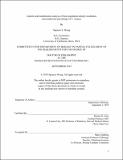Genetic and metabolomic analysis of how population density modulates neuroendocrine physiology of C. elegans
Author(s)
Wong, Spencer S.(Spencer Sai Git)
Download1138020019-MIT.pdf (3.917Mb)
Other Contributors
Massachusetts Institute of Technology. Department of Biology.
Advisor
Dennis H. Kim.
Terms of use
Metadata
Show full item recordAbstract
In nature, organisms are presented with ever-changing environmental stimuli that can be beneficial or detrimental. Distinguishing the critically important environmental cues from the insignificant ones is integral to the survival of the organism. These cues may be based on chemical communication, secreted from other organisms, both the same and different species, present in the same area. Chapter One of this thesis discusses chemical communication, specifically in Caenorhabditis elegans, throughout development, mating, and foraging for novel food sources. It also extends the description of chemical communication to include a wide variety of organisms from bacteria to vertebrates in various applications. In Chapter Two, we discuss the importance of insulin-like signaling in determining the reproductive duration of adult C. elegans. We show that the expression of an insulin-like peptide, INS-6, is downregulated in the presence of crowding and is mediated by ascaroside pheromones. The addition of synthetic ascarosides, as well as mutations that disrupt ins-6, increase the reproductive span of C. elegans. In Chapter Three, we analyze expression changes of the TGF-[beta]-like ligand, DAF-7, in ASJ. Based on previous work that showed daf-7 is expressed in ASJ upon exposure to Pseudomonas aeruginosa, we expanded the bacterial substrates that produce this phenotype, focusing in on a nonpathogenic Gram-positive bacterium Bacillus subtilis. We also show that wild isolates of C. elegans vary in their expression of daf-7 in ASJ, even on E. coli, which produces no daf-7 in laboratory wild-type strains. The induction of daf-7 in ASJ by B. subtilis is modulated by population density-dependent cues, through the canonical ascaroside pheromones and daf-22-independent pheromones. The expression of daf-7 in ASJ is also sensitive to secreted natural products from Pristionchus pacificus, a predator of C. elegans. In Chapter Four, I present ideas for expanding on the findings within these two projects. Specifically, I focus on the chemical identification of the modulators of daf-7 and the global transcriptional responses in ASI and ASJ upon elevated population density.
Description
This electronic version was submitted by the student author. The certified thesis is available in the Institute Archives and Special Collections. Thesis: Ph. D., Massachusetts Institute of Technology, Department of Biology, 2019 Cataloged from student-submitted PDF version of thesis. Includes bibliographical references.
Date issued
2019Department
Massachusetts Institute of Technology. Department of BiologyPublisher
Massachusetts Institute of Technology
Keywords
Biology.